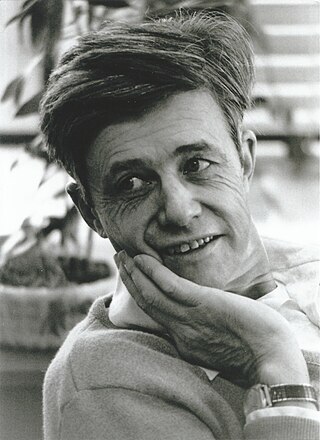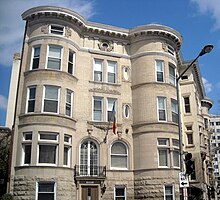
APL is a programming language developed in the 1960s by Kenneth E. Iverson. Its central datatype is the multidimensional array. It uses a large range of special graphic symbols to represent most functions and operators, leading to very concise code. It has been an important influence on the development of concept modeling, spreadsheets, functional programming, and computer math packages. It has also inspired several other programming languages.

A mainframe computer, informally called a mainframe or big iron, is a computer used primarily by large organizations for critical applications like bulk data processing for tasks such as censuses, industry and consumer statistics, enterprise resource planning, and large-scale transaction processing. A mainframe computer is large but not as large as a supercomputer and has more processing power than some other classes of computers, such as minicomputers, servers, workstations, and personal computers. Most large-scale computer-system architectures were established in the 1960s, but they continue to evolve. Mainframe computers are often used as servers.

In computing, time-sharing is the concurrent sharing of a computing resource among many tasks or users by giving each task or user a small slice of processing time. This quick switch between tasks or users gives the illusion of simultaneous execution. It enables multi-tasking by a single user or enables multiple-user sessions.

Computer operating systems (OSes) provide a set of functions needed and used by most application programs on a computer, and the links needed to control and synchronize computer hardware. On the first computers, with no operating system, every program needed the full hardware specification to run correctly and perform standard tasks, and its own drivers for peripheral devices like printers and punched paper card readers. The growing complexity of hardware and application programs eventually made operating systems a necessity for everyday use.

The Michigan Terminal System (MTS) is one of the first time-sharing computer operating systems. Created in 1967 at the University of Michigan for use on IBM S/360-67, S/370 and compatible mainframe computers, it was developed and used by a consortium of eight universities in the United States, Canada, and the United Kingdom over a period of 33 years.

Kenneth Eugene Iverson was a Canadian computer scientist noted for the development of the programming language APL. He was honored with the Turing Award in 1979 "for his pioneering effort in programming languages and mathematical notation resulting in what the computing field now knows as APL; for his contributions to the implementation of interactive systems, to educational uses of APL, and to programming language theory and practice".

Amdahl Corporation was an information technology company which specialized in IBM mainframe-compatible computer products, some of which were regarded as supercomputers competing with those from Cray Research. Founded in 1970 by Gene Amdahl, a former IBM computer engineer best known as chief architect of System/360, it has been a wholly owned subsidiary of Fujitsu since 1997. The company was located in Sunnyvale, California.

The IBM 5100 Portable Computer is one of the first portable computers, introduced in September 1975, six years before the IBM Personal Computer, and eight before the first successful IBM compatible portable computer, the Compaq Portable. It was the evolution of a prototype called the SCAMP that was developed at the IBM Palo Alto Scientific Center in 1973. Whether considered evolutionary from SCAMP or revolutionary, it still needed to be plugged into an electric socket.
The BUNCH was the nickname for the group of mainframe computer competitors of IBM in the 1970s. The name is derived from the names of the five companies: Burroughs, UNIVAC, NCR, Control Data Corporation (CDC), and Honeywell. These companies were grouped together because the market share of IBM was much higher than all of its competitors put together.
I. P. Sharp Associates (IPSA) was a major Canadian computer time-sharing, consulting and services firm of the 1970s and 1980s. IPSA is well known for its work on the programming language APL, an early packet switching computer network named IPSANET, and a powerful mainframe computer-based email system named 666 Box, stylized as 666 BOX. It was purchased in 1987 by Reuters Group, which used them until 2005 as a data warehousing center for business data.
Plug compatible refers to "hardware that is designed to perform exactly like another vendor's product." The term PCM was originally applied to manufacturers who made replacements for IBM peripherals. Later this term was used to refer to IBM-compatible computers.
Lawrence Moser "Larry" Breed was a computer scientist, artist and inventor, best known for his involvement in the programming language APL.

Irma board, originally spelled IRMA board, refers to a brand of coaxial interface cards for PCs and Macintosh computers used to enable 3270 emulator programs to connect to IBM mainframe computers. IRMA boards were used to connect PCs and Macs to IBM 3274 terminal controllers.

Digital Effects Inc. was an early and innovative computer animation studio at 321 West 44th street in New York City. It was the first computer graphics house in New York City when it opened in 1978, and operated until 1986. It was founded by Judson Rosebush, Jeff Kleiser, Don Leich, David Cox, Bob Hoffman, Jan Prins, and others. Many of the original group came from Syracuse University, where Rosebush taught computer graphics. Rosebush developed the animation software APL Visions and FORTRAN Visions. Kleiser later went on to found Kleiser-Walczak Construction Company, which experimented with creating synthespians and made the animation for Monsters of Grace.
The IBM Type-III Library was software provided by IBM to its customers, available without charge, liability, or support, and typically in source-code format. The best known examples are for mainframe software, but IBM also used this same classification on smaller systems.
Shared Variables are a feature of the programming language APL which allows APL programs running on one processor to share information with another processor. Although originally developed for mainframe computers, Shared Variables were also used in personal computer implementations of APL. Shared Variables could be used to control peripheral devices, or to communicate with external files, database management systems, or other users. Shared Variables were first introduced by International Business Machines Corporation (IBM) in their APL.SV software product in 1973, and are still available as of 2017, in APLs from IBM and Dyalog, for the operating systems Linux and Windows.
The Universal Time-Sharing System (UTS) is a discontinued operating system for the XDS Sigma series of computers, succeeding Batch Processing Monitor (BPM)/Batch Time-Sharing Monitor (BTM). UTS was announced in 1966, but because of delays did not actually ship until 1971. It was designed to provide multi-programming services for online (interactive) user programs in addition to batch-mode production jobs, symbiont (spooled) I/O, and critical real-time processes. System daemons, called "ghost jobs" were used to run monitor code in user space. The final release, D00, shipped in January, 1973. It was succeeded by the CP-V operating system, which combined UTS with features of the heavily batch-oriented Xerox Operating System (XOS).
CP-6 is a discontinued computer operating system, developed by Honeywell, Inc. in 1976, which was a backward-compatible work-alike of the Xerox CP-V, fully rewritten for Honeywell Level/66 hardware. CP-6 was a command line oriented system. A terminal emulator allowed use of PCs as CP-6 terminals.
Philip S. Abrams is a computer science researcher who co-authored the first implementation of the programming language APL.










